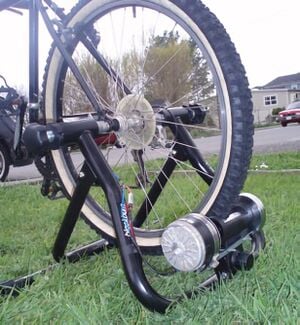
A pedal powered generator is a Human Powered Energy Generator (HPEG) that provides a method of generating electricity by means of a modified exercise bike for use in energy storage and running household appliances. Human/mechanical energy is converted into electrical current by means of a Direct Current (DC) generator that is connected by a fanbelt to an exercise bike flywheel.
The energy created by the DC generator can be stored in various types of lead-acid batteries. Energy stored in battery form can act as a supplemental energy source for battery banks that may already be used for wind, hydro and photovoltaic systems. Also, energy that is stored within the lead-acid battery can be utilized as DC current for use in DC appliances such as those found in automotive mobile homes. If Alternating Current (AC) appliances are in place then an inverter must be used to transfer the 12 volts of DC current into the standard 110 volts of AC current for usage by these appliances.
For a complete guide on how to build a pedal powered generator visit Bicycle generator: The ultimate how to guide (With examples!)
Introduction[edit | edit source]
As discussed in Pedal Power: In work, leisure, and transportation by James McCullagh (1977), tests at Oxford by Stuart Wilson on a bicycle showed that 75 watts of power is possible to be generated by an average rider at road speed in a one hour time frame. Wilson also found that at 18 mph it is possible to achieve 200 watts for short periods, while 750 watts is possible only for a second or so, under extreme load. These calculations show that human/mechanical energy, if harnessed could add to existing battery banks, or could be set up alone to run appliances. Appliances that could be powered include radios, televisions, lights, power tools and other appliances that pull relatively low amounts of energy for their usage.
Now that the potential power output for an average cyclist has been defined it is possible to design a human powered energy generator. The information that is contained within this web page is intended to allow the reader to examine potential uses for this design. This example is based upon calculations done by myself, and can be used as a template for design of different energy demand systems. This system would be most appropriate for a household with more than four people that do not have high energy demands, and are in average physical condition.
Written by Ben Erickson